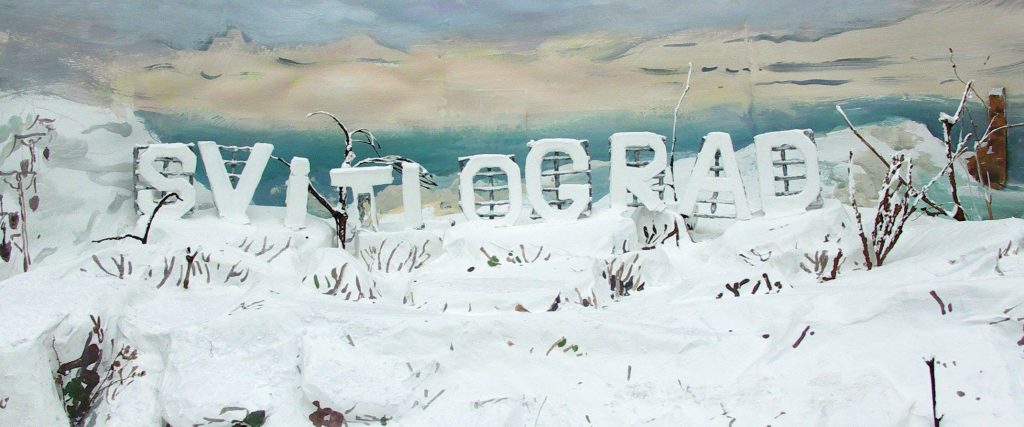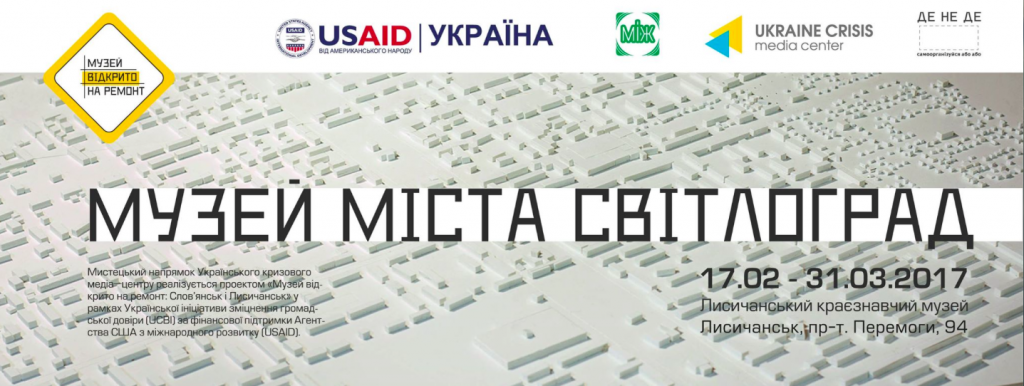On Friday, February 17, at 4pm, “Svitlograd Museum” exhibition opens in Lysychansk Local History Museum
(pr. Peremohy, 94). Curators of the project – art initiative DE NE DE.
Through “Svitlograd Museum” exhibition** artists reveal the idea of the museum in the context of urban utopia and search for ways to materialize the unattainable dream of a contemporary art museum in Ukraine, because today it is utopian to Ukrainian artistic community. Lysychansk Local History Museum develops principles of a creative laboratory of new museology. By experimenting with new museum and exhibition methods, artists give meaning to Svitlograd history and myth, its role and importance for modern towns in Luhansk region (Syeverodonetsk, Lysychansk, and Rubizhne), consider important issues of representing history in the light of this myth. They seek optimal ways of individual and public perception of information, new forms to structure an exhibition. The exhibition is supposed to change during its work and go beyond the museum to the urban environment, instead of being static.
A series of public events will be held in January – March 2017: film screenings, presentations, artist talk – at Lysychansk Local History Museum, Crisis Media Center “Siverskyi Donets” and Rubizhne Central Library.
“Svitlograd Museum” exhibition will be open from February 17 to March 31 within Lysychansk Local History Museum (pr. Peremohy, 94) working hours.
Curators: art initiative DE NE DE.
PARTICIPANTS:
DisOrder, Enjoy, Vitaliy Atanasov, Mykhaylo Alekseyenko, Dana Brezhneva, Volodymyr Vorotnyov, Ksenia Hnylytska, Olha Honchar, Sasha Dolhyi, Olexandr Yeltsin, Anastasia Zhyvkova, Lusia Zoria, Mykyta Kadan, Max Lyzhov, Leonid Maruschak, Yevhen Molyar, Serhiy Popov, Olexiy Radynskyi, Andriy Rachynsky, Daniil Revkovskyi, Mykola Ridnyi, Anton Smirnov, Anatoliy Tatarenko, Olexandr Telyuk, Leo Trotsenko, Alina Yakubenko
“UNDER CONSTRUCTION: MUSEUM OPEN“ is a project that will last for four months from November 2016 to March 2017 in the local history museums of Slovyansk (Donetsk region) and Lysychansk (Luhansk region). It is a research project which will enlist the cooperation of museum curators, Ukrainian and international artists and experts, provide the museums with modern technical equipment, organize training for the museum staff, develop and implement a PR concept for each museum. The project will result in arranging the exhibitions, a number of training activities for the museum staff and visitors, as well as methodological recommendations for the further development of the museums.
The Arts Department of Ukraine Crisis Media Center conducts the project “Under construction: Museum open: Slovyansk and Lysychansk” within the project “Ukraine Confidence Building Initiative (UCBI)” with the financial support of the United States Agency for International Development
For further information, please contact Arif Bagirov, communications coordinator of “Under construction: Museum open: Lysychansk”, ([email protected]) (066) 374-81-36
Project news and upcoming events подій #музейвідкритонаремонт #UCBI #музейсловянськ #музейлисичанськ #любитазнайсвійріднийкрай #Україна #світлоград #svitlograd #денеде #denede
Facebook: https://www.facebook.com/lismuseum/
VK: https://vk.com/lis.museum
Одноклассники: https://ok.ru/group/53224893055193
YouTube: https://www.youtube.com/channel/UC5EQHTt8JRi-xgkonK4ptxA
Instagram: https://www.instagram.com/lis.museum/

* Myth of Svitlograd
Svitlograd is a potential name of the agglomeration of several towns in Luhansk region, which was formed in the 30s of the twentieth century, after Syeverodonetsk was built *. The construction of the town and launching of the Azot plant were crucial for the agglomeration development, creating a gravitational triangle – Lysychansk, Syeverodonetsk, Rubizhne.
Today, the chemical industry in the region, which opened prospects for developing Svitlograd – an extensive urban formation, has become privately owned by Ukrainian oligarchs and almost lost its production capacity. What declaratively united these cities in the past – communist ideology – is banned now. Svitlograd’s chronological origin – the Soviet period history – is stigmatized and subjected to manipulative interpretation. Memories of agglomeration are preserved mostly in local residents’ oral narrations. The three cities are losing their memories of Svitlograd, and this leads to some estrangement between them. The nearby localities are losing their cultural and other ties, minimizing interaction. At the beginning of the armed conflict in Donbas in 2014, one of the bridges connecting Syeverodonetsk and Lysychansk was blown up.
In the second half of the 20th century, the so-called “Triangle of death” was formed within the three neighboring cities instead of Svitlograd. Powerful chemical production had a dramatically devastating impact on the regional ecology. The locals remember “acid rains” and dead fish in the rivers when the industry was flourishing. The decline of these enterprises led to considerable economic collapse in the region, but was of salubrious value for the environment. People noticed how birds returned to the woods, and fish appeared in the Siverskyi Donets.
* In the mid-twentieth century, there were many names associated with these cities: Troyegrad, Liskhimstroy, Myendyelyeyevsk etc.
** “Svitlograd Museum”: chronology
The “Svitlograd” project of DE NE DE artistic initiative began in November 2016. Sasha Dolhyi, born in Lysychansk, initiated creative rethinking the history of urban education in Luhansk region, dated in the early 20th century, and created a series of graffiti tags “Svitlograd” in Syeverodonetsk.
In January 2016, Sasha Dolhyi presented his art work “Case ‘Svitlograd’”- a series of architectural models of public spaces in the utopia town and archive materials related to Svitlograd.
In November 2016, the DE NE DE project participants continued their creative research into Svitlograd myth, which resulted in a temporary exhibition at Lysychansk Local History Museum called “Svitlograd Museum” in February 2017.









